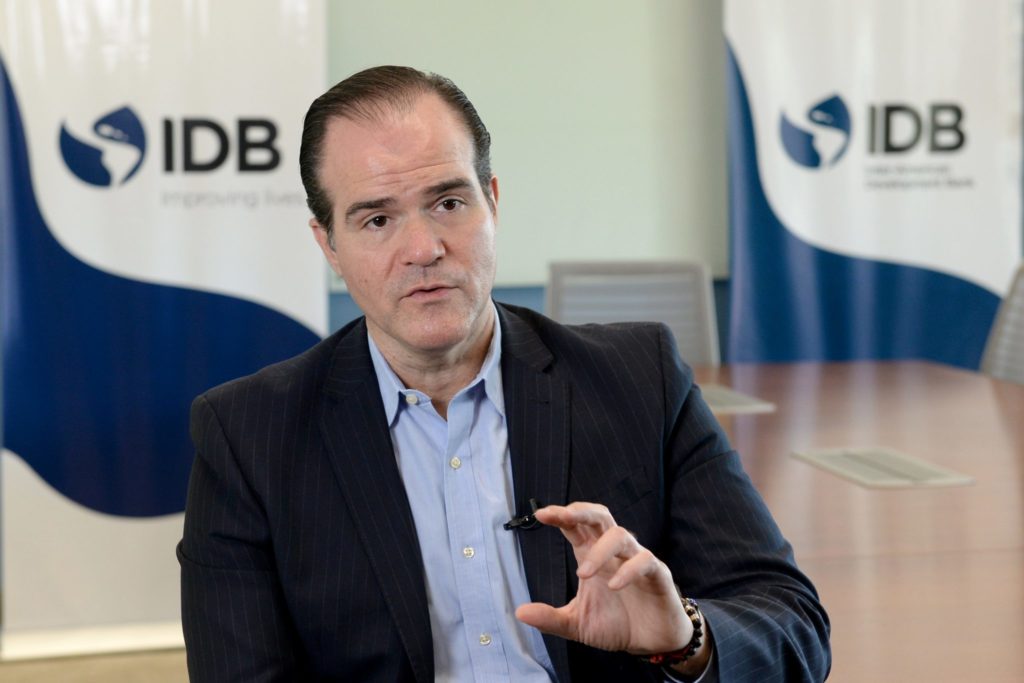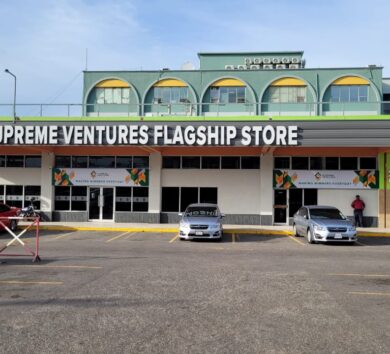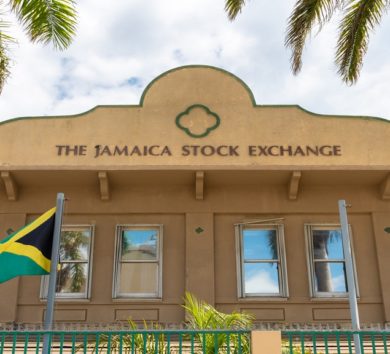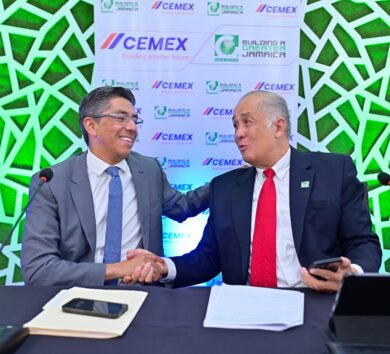

Mauricio Claver-Carone, president of the Inter-American Development Bank (IDB), says the COVID-19 pandemic and the ongoing global supply chain crisis has opened up a new reality that’s led to an unprecedented opportunity for Latin American and Caribbean countries to attract foreign direct investment and increase exports through nearshoring.
“From day one, we said we would we take advantage of this historic realignment [of the global supply chain], and we’re putting our money where our mouth is,” Claver-Carone indicated.
“The IDB, along with the government of Japan, is the only institution in the world actively financing nearshoring. With global shortages of everything from cars to microchips, this is a once in a lifetime opportunity for the region and we must seize it now.
“The region also has distinct competitive advantages, including advantages in clean energy, that will allow it to attract investment. Clean energy matrixes in Costa Rica and Uruguay, for example, make both countries extra appealing to investors who want sustainable supply chain.”
With Claver-Carone’s stance on nearshoring in mind, the IDB has put together a strategy offset the global supply chain crisis.
IDB NEARSHORING STRATEGY
KEY BACKGROUND
· Companies want to invest in regional supply chains.
· Earlier this year, a Kearney survey of 120 U.S. manufacturing executives found that:
– 47% want to diversify supply chains over the next three years
– 41% specifically said they are trying to reduce reliance on China.
· More than 75% of US companies with factories in Asia have decided or are considering relocating part of their operations to other countries, according to a study by the UBS Evidence Lab.
· Also, according to a 2020 Gartner survey, at least 33% of 260 world leading companies plan to move part of their chains out of Asia by 2023.
· A recent IDB study estimates that if LAC captured just 10% of US imports from its top 10 source destinations outside the Western Hemisphere, of products that LAC already exports to the US or Europe (meaning that LAC companies are already good at), the region could increase its exports of goods by more than $70 billion annually.
· LAC is one of the least integrated regions in the world. Just 14% of our trade takes place intra-regionally, compared to about 60% in Europe and 40% in East Asia. Increasing integration would increase both internal trade but also make it more appealing for companies to invest in nearshoring in the region.
· Harmonizing the complex network of 30+ intra-hemispheric trade agreements could increase intraregional trade by 12%–or $20 billion.

What the IDB is doing
· The IDB created a “nearshoring toolkit” to help countries and make all our tools available to countries.
· The toolkit includes everything from financing and grants to access to applied research, strategic partnerships, and advisory services. It also offers capital investments and loan guarantees.
· The IDB is also leading an effort in 16 countries to identify products and sectors that can readily benefit from nearshoring. That includes proposing policies and projects to help countries seize nearshoring opportunities. The IDB plans to complete this work in all 26 member countries in the coming months.
Costa Rica
· In Costa Rica, the IDB is analysing the semiconductor sector to see how the country can increase investment and improve supply chains.
Dominican Republic
· In the Dominican Republic, the IDB approved a project to modernize local port facilities. This will enable exporters there to ship textiles, food, electronics and other goods to the U.S. It will also reduce logistics costs, also making the country more attractive for other investments in nearshoring.
Colombia
· In Colombia, the IDB is working with the government on its nearshoring strategy, including for its automotive industry.
· President Duque has been an outstanding ambassador for nearshoring in the Americas.
Uruguay
· The IDB is funding “finishing schools” to train thousands of employees from over 200 companies in fields like IT, healthcare and architecture. Thanks to programs like this, over 30 international companies have invested or expanded operations in Uruguay. Ecuador · The IDB designing an Electronic Single Window for Investor Services. This helps increase FDI by reducing the time and cost of trade.
Region
· Costa Rica, Colombia and Guatemala are placing high priority on boosting FDI. The IDB is working closely with trade promotion agencies in each of these countries and has held nearshoring events in the countries.
· Along with the presidents of Costa Rica and Guatemala, respectively, the IDB inaugurated nearshoring promotion events.
· In Costa Rica, the IDB did “The power of collaborative nearshoring ecosystems to drive truly sustainable productivity” event. In Guatemala, the IDB did the “Guatemala No Se Detiene: Strengthening Regional Value Chains for Economic and Social Reactivation” event.
· Presidents Carlos Alvarado of Costa Rica and Alejandro Giammattei of Guatemala are key proponents of nearshoring want companies to invest or reinvest in strategic sectors.
· The IDB has held investment events with more than 100,000 businesses.
The Amazon region
· In the Amazon area, the IDB’s trade & integration department is conducting a study showing that firms and communities based in the Amazon already know how to export 60 different products that can be produced in harmony with the forest.
· These exporters are making about $300 million per year, out of a potential $160 billion total market for these products.
· In July 2021, the IDB started using its Connectamericas’ SME platform to facilitate virtual matchmaking activities between Amazon-region producers and international buyers. The event brought together 115 local producers and 48 international buyers, resulting in an estimated $25 million in transactions.
Supply chains and climate
· The issue of supply chains has become inextricably linked to climate change. Shipping products back and forth from West to East and back, and then North, makes no environmental sense. This is an opportunity that Latin America can seize.
· Increasingly, both countries and companies are going to require for exporters to show that their supply chains are environmentally sustainable and have a lower carbon footprint.
· That will benefit Latin America and the Caribbean if they ensure they’re sustainably producing goods and services.
· The region already has a big advantage of others because such a high percentage of its energy matrix is clean.
· Several countries, including Costa Rica and Uruguay, get nearly 100% of their power from renewable energy. Brazil gets most of its energy from renewables.
· Increasingly, importers around the world are going to pay a premium for green supply chain products. This is a big opportunity for Latin America.
· This isn’t just a logistical issue. It’s an environmental issue.
· Producing so many things so far away raises the carbon footprint of the goods shipped to consumers.
· That makes nearshoring and supply chains an ESG issue for investors who want to invest in environmentally sustainable companies.
· Because of that, the IDB is working on an analysis of trade and its carbon footprint in the region.
· The IDB is also working on a potential plan to help certify the green nature of regional manufacturing and exports.
· This is important because, increasingly, countries and companies will require suppliers to certify that they’re operating sustainably.
COUNTRIES AND RECENT CASES
Uruguay
· Volkswagen chose Uruguay to implement a test phase in 100% electric cars. Volkswagen chose Uruguay as the location for its Latin American test phase of all-electric vehicles, citing good road infrastructure, technology parks, data centers, and its 98% clean energy matrix, which is a must-have for the German conglomerate. Volkswagen expects to complete the testing to be able to sell this type of unit in Uruguay by 2022. Volkswagen plans to build a hub to manage fleets sold in the region.
Costa Rica
· In July, Intel said it would increase its investment a microchip plant in Costa Rica to $600 million, citing high demand for chips.
· Amazon’s services center in Costa Rica employs over 17,000 workers.
· IDB Invest is financing the pharmaceutical company Calox and the industrial ship maker Guerrero Gran Park.
· Costa Rica is already a top medical device exporter. It recently opened a new trade office in Houston. In 2020, Texas alone imported over $400 million in goods from Costa Rica.
Colombia
· Teleperformance, a French IT and outsourcing services multinational, which has 27 offices in Colombia, and plans to hire another 10,000 remote employees.
· Amazon announced it would hire 2,000 more employees in Colombia, to serve to the Americas.
Guatemala
· In 2020, Nestle inaugurated its largest Distribution Center in the region in Guatemala. On October 22, Nestlé inaugurated its Distribution Center in Guatemala, the largest in Central America. It will create over 1,500 direct and indirect jobs. Will be a hub for culinary exports, as well as imports and exports to the U.S., Mexico, and Brazil.
Country opportunities
· In Jamaica, for example, the IDB has found concrete opportunities for business and knowledge process outsourcing over the short term and on warehousing, transshipment, and manufacturing distribution services in the medium term.
· Uruguay has immense opportunities in software development and audiovisual services in the short term and on pharmaceuticals, shared services centers, medical devices, and biotechnology in the medium term.
· In Ecuador, the IDB is helping to design an Electronic Single Window for Investor Services. This helps increase FDI by reducing the time and costs faced by foreign investors.
· In Honduras, textile and light manufacturing, as well as call centers and business process outsourcing, are sectors that are well positioned to attract investment as value chains shift.
· Colombia has comparative advantages and prospects of attracting companies in the food manufacturing, automotive and steelmaking sectors in the short term and within the electrical equipment and auto parts sectors in the medium term.
· The Dominican Republic could benefit from quick wins in the medical devices, cables, textile, and footwear sectors







Comments